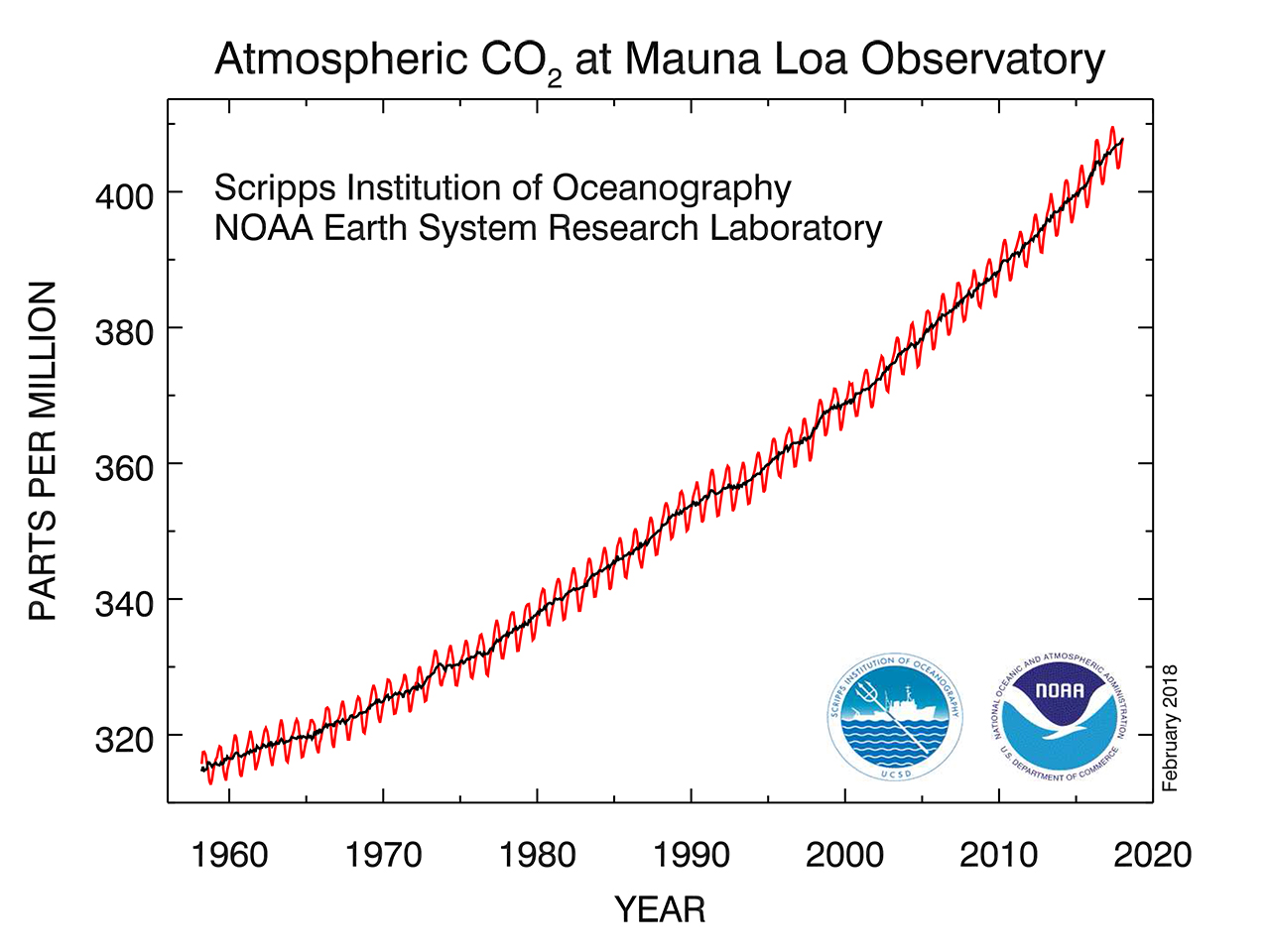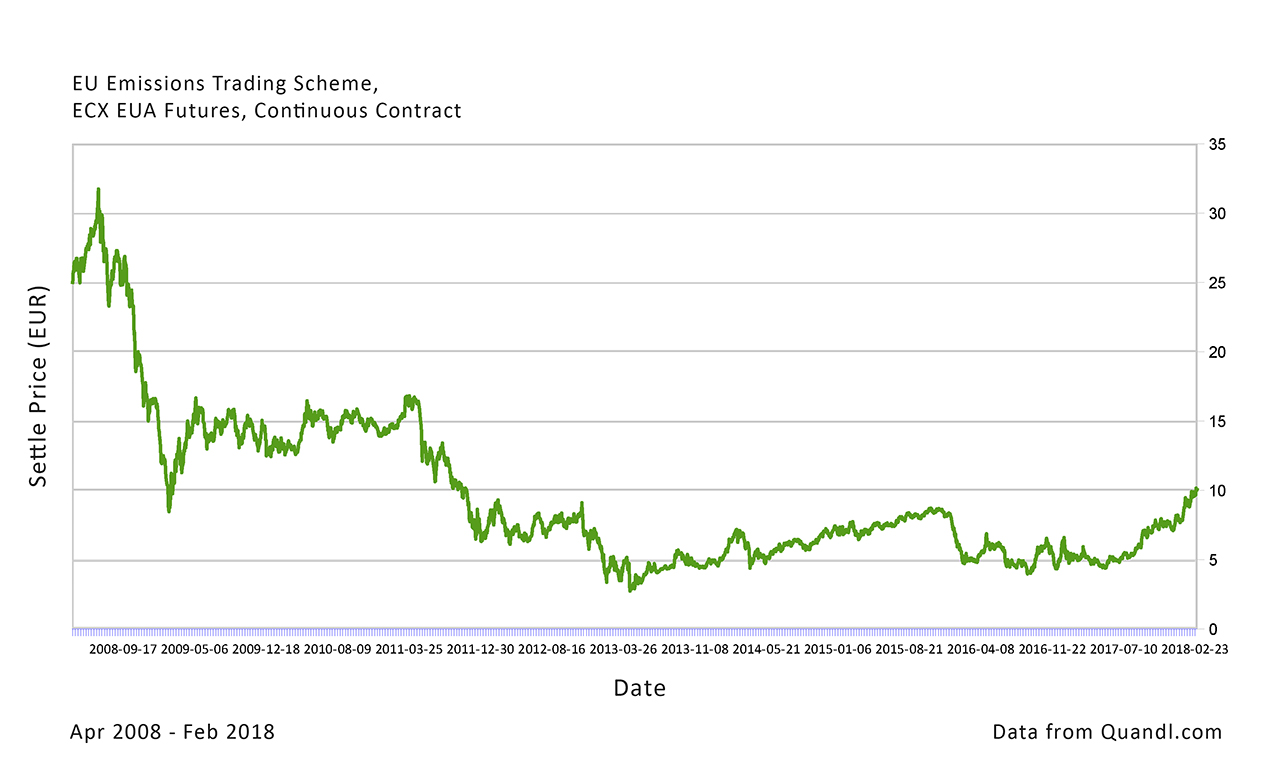Carbon Dioxide
mirko nikolić

Carbon-dioxide (CO2) takes a panoply of embodiments as it circulates between the atmosphere, animal bodies, plants, rocks, motor engines, etc. Various bodies capture, transform, or release carbon-dioxide, contributing to the carbon cycle (Volk, 2008). This vital circulation is all-pervading and ubiquitous, a transcorporeal intra-activity that brought about the emergence of life from nonlife. Yet, in a twist of evolutionary adaptation, CO2 in common everyday levels is intangible to human sensorium. Through the advancements of climate sciences, carbon-dioxide has eventually become a major (or minor) public or political subject, more than a 'matter of concern' (Latour, 2004) inasmuch as it calls for a broad quantum leap on system level.
The concentration of CO2 in the atmosphere is meticulously tracked since 1958 when Charles David Keeling began its measurement in a laboratory in Mauna Loa, Hawaii. The in-progress Keeling Curve, colloquially called the 'hockey stick graph', informs us that CO2 is rising. Since CO2 is one of the primary greenhouse gases, its measured values are strong indicators of the rising temperatures or global warming (see IPCC, 2013). The shadow of this odourless, colourless and quite rarefied element looms large over our societies, though less heavily so on some than others.

Since 2005, in Europe, CO2 has become a commodity. It can now be bought or sold per metric tonne. The commodity form of CO2 is the object of the European Union Emission Trading Scheme (EU ETS), which is "a cornerstone of the EU's policy to combat climate change" (EU Commission, 2018, my emphasis). The stated mission of the trading scheme is to progressively reduce pollution in order to meet the sustainability targets of the EU in view of the Kyoto Protocol[1]. The rationale for setting up the market is laid out in these terms:
By putting a price on carbon and thereby giving a financial value to each tonne of emissions saved, the EU ETS has placed climate change on the agenda of company boards and their financial departments across Europe. A sufficiently high carbon price also promotes investment in clean, low-carbon technologies. (EU Commission, 2013, p.2).
The EU is betting on 'a market instrument' to quantise one of the major causes of a complex and transversal problem such as global warming. EU ETS, an advanced political-economic instrument forged in one of the most developed parts of the world, shows how, more than half a century after the first scientific alerts, magically and perversely global warming is not real, or rather, that CO2 is not as real as financial-political interests.
The EU ETS is arguably a highly sophisticated legal-financial apparatus but, in the last instance, it institutes a rather simplified cut between economy and ecology (while claiming to inter-link the two). The Scheme deals exclusively with emissions, thereby excluding a multitude of entities from (political and economic) existence. Hence all other participants and processes that take part in an infinitely more complex ecology of carbon circulation are once again made invisible and, by so doing, their appropriation still continues. Clamorously overshadowed is the question: what, or rather, who is going to re-absorb (or 'fixate') all the emitted CO2? The answer is straightforward: photosynthetic organisms. Plants, trees, shrubs, phytoplankton, algae, and many others organisms who day after day labour from dawn to sunset to absorb CO2, and which in turn, through a series of the most astonishing chemical metamorphoses, give out oxygen. Vegetal-being is completely out of the carbon market equation and its economical apparatus. The EU ETS thus perpetuates the established economic tradition of environmental 'externalities', even as it partially internalises greenhouse gas emissions.

Can we render justice to these speeds and slownesses with an instrument such as carbon emissions with quarterly expiry dates? This particular apparatus, as well as numerous others that belong to the 'green economy', do not challenge the dominant logics of the "anthrobscene" (Parikka, 2014), or modernity entwined with capitalist development. In considering this disjunction between these apparatuses and climatic processes, we can see that 'lifetime' or the rate of absorption of greenhouse gases in the atmosphere ranges from a couple of decades to thousands of years:
Within several decades of CO2 emissions, about a third to half of an initial pulse of anthropogenic CO2 goes into the land and ocean, while the rest stays in the atmosphere. Within a few centuries, most of the anthropogenic CO2 will be in the form of additional dissolved inorganic carbon in the ocean, thereby decreasing ocean pH. Within a thousand years, the remaining atmospheric fraction of the CO2 emissions is between 15 and 40%, depending on the amount of carbon released (Archer et al., 2009b). (IPCC, 2013, p.472).

The issue at stake here is to think and enact social apparatuses – institutions and organisations – that are not grounded on anthropocentric premises or conventional understandings of sustainability that solely worry about human interests, and only for some parts of humanity at that. The emergence of CO2 as a political subject is even more complex than, for example, contentions around plastics or uranium, because it is a medium quintessential to vegetal and animal life. Carbon-dioxide enfolds together life and nonlife, pasts, present, and future. This companion molecule is differently mobilised by fossil capitalism and political agendas and various claims are made on its concentration in the atmosphere. As quantum physics shows, this is a dramatic case of the radical entanglement of agencies of observation and the observer, observable now on a planetary scale. "Taking account" of carbon-dioxide does not begin nor end with an atmospheric sensor or even climate science, rather, it demands "ac/counting" (Barad, 2012, p.46) for complex technoscientific, bureaucratic apparatuses and physical processes, measurements that must always involve 'us', "for all accountings are from within, not without" (ibid., p.47). More just and "response-able" (Schrader, 2010) material-discursive entanglements with this companion molecule would imply practices of intra-activity that ac/count for the "deep times" and "future future[s]" (Morton, 2013) of carbon-dioxide's agency: its queer "transcoporeality" (Alaimo, 2010) and quantum historicity. Natureculture apparatuses that would be ac/countable and response-able for CO2 are territories demanding what Bühlmann, Colman and van der Tuin have called "quantum thinking" (2017, p.47), an ethico-political urgency for eco-queer-feminist new materialisms. Naturecultures of multispecies sustainability cannot forget the composition of air.
Notes
1. EU ETS is the largest greenhouse emission trading scheme in the world, but 'carbon trading' is a global phenomenon. Other major markets are South Korean, Australian, New Zealand, and Californian emission trading schemes. Chicago Climate Exchange ran a voluntary carbon emissions cap and trade from 2003 through the end of 2010. Its subsidiary the Chicago Climate Futures Exchange ran until end of February 2012. Kyoto Protocol itself also includes four mechanisms for carbon emission trading among nations, signatories of the treaty.
Images
Fig. 1. #air293: all that is air melts into city. mirko nikolić, dracaena marginatas, Declan Driver, Steffen Michels, CC BY-NC-ND 4.0.
Fig. 2. ECX EUA Futures, Continuous Contract, 2008-2018. Graph from Quandl.com data.
Fig. 3. Full Mauna Loa CO~2~ Record. Dr. Pieter Tans, NOAA/ESRL (www.esrl.noaa.gov/gmd/ccgg/trends/) and Dr. Ralph Keeling, Scripps Institution of Oceanography (scrippsco2.ucsd.edu/).
Fig. 4. #air347: all that is air melts into city. mirko nikolić, dracaena marginatas, Declan Driver, Steffen Michels, CC BY-NC-ND 4.0.
Synonyms: breath, respiration, photosynthesis, carbon cycle, atmosphere, in/organic, quantum thinking
Antonyms: capital, carbon stocks, anthropocene, externality
References
Barad, K. (2012). Nature's queer performativity. Kvinder, Køn & Forskning, pp.1-2, pp.25--53.
Bühlmann, V., Colman, F., & van der Tuin, I. (2017). Introduction to New Materialist Genealogies: New Materialisms, Novel Mentalities, Quantum Literacy. minnesota review, 88, 47--58.EU Commission (2018) The EU Emissions Trading System (EU ETS). Accessible at: https://ec.europa.eu/clima/policies/ets\_en
Intergovernmental Panel on Climate Change (2013). Climate Change 2013: The Physical Science Basis. Contribution of Working Group I to the Fifth Assessment Report of the Intergovernmental Panel on Climate Change. Cambridge, UK; New York NY.
Latour, B. (2004) Why Has Critique Run out of Steam? From Matters of Fact to Matters of Concern. Critical Inquiry 30 (Winter), pp. 225-248.
Morton, T. (2013). Hyperobjects: Philosophy and Ecology after the end of the World. Minneapolis: University of Minnesota Press.
Parikka, J. (2014). The Anthrobscene. Minneapolis: University of Minnesota Press.
Schrader, A. (2010). Responding to Pfiesteria piscicida (the Fish Killer): Phantomatic Ontologies, Indeterminacy, and Responsibility in Toxic Microbiology. Social Studies of Science, 40(2), pp.275--306.
Volk, T. (2008). CO~2~ Rising: The World's Greatest Environmental Challenge. Cambridge, MA: MIT Press.
COST Action IS1307 New Materialism: Networking European Scholarship on 'How Matter Comes to Matter'.
Here you will find background material, current activities, calls for papers, working group information, and project outputs.
With the changing of societies on local, national and international scales owing to economic, ecological, political and technological developments and crises, a reorganized academic landscape can be observed to be emerging. Scholarship strives to become increasingly interdisciplinary in order to grasp and examine the unfolding complexity of ongoing ecological, socio-cultural and politico-economic changes. Additionally, academics forge... Read more or find out Who's Who
- Call for Papers - Technology Matters and Matters of Technology: Exploring Theories of "Materiality" for Technology Research - June 25, 2018
- The return of materialism(s)? Matter between science, theory and art - University of Iceland
- Call for Entries - New Materialism Almanac 2018
- Urban Matters: Material Engagements with Communities and Borders in Times of Movement
Information relating to activities undertaken, including conferences, training schools, short-term scientific missions, and annual meetings, are archived here.
Filter activities by:
Conference7
Other7
STSM7
Training School7
- 7th Annual Conference: Performing Situated Knowledges: Space, Time, Vulnerability
- From Cosmos to Genes: New Materialist Methodologies Crossing the Humanities, Natural, and Technosciences
- MC Meetings: Barcelona, Maribor and Warsaw
- Training School 2: Research Genealogies and Material Practices
Working Groups focus on four key areas of research
Working Group One
Genealogies of New Materialisms; examines and intervenes in canonization processes by compiling a web-based bibliography, coordinating the OST 068/13 8 EN... Read more
Working Group Two
New Materialisms on the Crossroads of the Natural and Human Sciences; seeks to develop new materialisms at the boundaries of the human and natural sciences. The group focuses on how European new materialisms can rework the ‘Two Cultures' gap... Read more
Working Group Three
New Materialisms Embracing the Creative Arts; brings together European researchers, artists, museum professionals, and other activists with a keen interest in the material... Read more
Working Group Four
New Materialisms Tackling Economical and Identity – Political Crises and Organizational Experiments... Read more
2016–18
The Almanac comprises contributions from members of working groups, and participants in related activities, delineating key terms, more esoteric neologisms, and short provocations. Read more
New Materialism —
Networking European Scholarship on 'How matter comes to matter’

Website by Second Cousins

